《供应链管理》第一章习题
- 格式:docx
- 大小:17.69 KB
- 文档页数:4

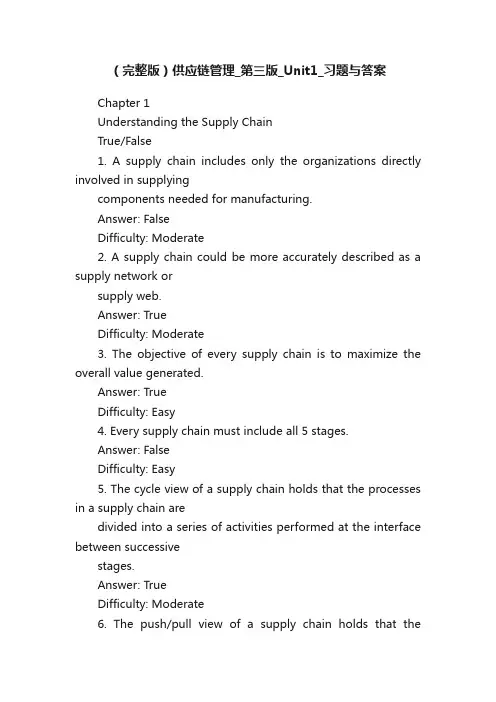
(完整版)供应链管理_第三版_Unit1_习题与答案Chapter 1Understanding the Supply ChainTrue/False1. A supply chain includes only the organizations directly involved in supplyingcomponents needed for manufacturing.Answer: FalseDifficulty: Moderate2. A supply chain could be more accurately described as a supply network orsupply web.Answer: TrueDifficulty: Moderate3. The objective of every supply chain is to maximize the overall value generated.Answer: TrueDifficulty: Easy4. Every supply chain must include all 5 stages.Answer: FalseDifficulty: Easy5. The cycle view of a supply chain holds that the processes in a supply chain aredivided into a series of activities performed at the interface between successivestages.Answer: TrueDifficulty: Moderate6. The push/pull view of a supply chain holds that theprocesses in a supply chainare divided into 2 categories depending on whether they are initiated in response to or in anticipation of customer orders.Answer: TrueDifficulty: Easy7. The objective of customer order entry is to maintain a record of product receiptand complete payment.Answer: FalseDifficulty: Hard8. The replenishment cycle occurs at the retailer/distributor interface.Answer: TrueDifficulty: Hard9. The manufacturing cycle occurs at the manufacturer/supplier interface.Answer: FalseDifficulty: Moderate10. The procurement cycle occurs at the manufacturer/supplier interface.Answer: TrueDifficulty: Easy11. The cycle view of the supply chain is useful when considering operationaldecisions, because it specifies the roles and responsibilities of each member of the supply chain.Answer: TrueDifficulty: Moderate12. The push/pull view of the supply chain is useful when considering strategicdecisions relating to supply chain design, because it categorizes processesbased on whether they are initiated in response to or in anticipation of customer orders.Answer: TrueDifficulty: Moderate13. Pull processes may also be referred to as reactive processes.Answer: TrueDifficulty: Easy14. Pull processes may also be referred to as speculative processes.Answer: FalseDifficulty: Easy15. All supply chain activities within a firm belong to one of three macro processes –CRM, ISCM and SRM.Answer: TrueDifficulty: Easy16. There is a close connection between the design and management of supplychain flows and the success of a supply chain.Answer: TrueDifficulty: EasyEssay/Problems1. Explain the 3 decision phases (categories) that must be made in a successfulsupply chain.Answer: The 3 decision phases that occur within a supply chain are supply chain strategy (or design), supply chain planningand supply chain operation. Decisions relate to the flow of information, product and funds. The difference between categories depends upon the frequency of each decision and the time frame over which it has an impact. During the supply chain strategy phase, a companydetermines what the chain’s configurations will be, how resources will beallocated, and what processes each stage will perform. This will establish thestructure of the supply chain for several years. Supply chain planning deals withdecisions with a time frame from 3 months up to a year. The planning phasemust work within the constraints established in the strategy phase. Planningdecisions include which markets to supply from which locations, subcontractingof manufacturing, inventory policies and timing and size of marketing promotions.The supply chain operation phase operates on a weekly or daily time horizon and deals with decisions concerning individual customer orders.Difficulty: Hard答:决策的3阶段发生在一个供应链的供应链战略(或设计),供应链与供应链运作。

供应链管理课后习题答案第一章、供应链管理导论1.供应链的结构特征是什么?将供应商、制造商、分销商、零售商、直到最终用户连成一个整体的功能网链结构。
2.何谓供应链管理?简述供应链管理与传统企业管理的区别和联系。
供应链管理就是使以核心企业为中心的供应链运作达到最优化,以最低的成本,另供应链从采购开始,到满足最终用户的所有过程,包括工作流、实物流、信息流、资金流等均高效率运作,把合适的产品,以合理的价格,及时准确的送到消费者手中。
区别:①传统企业的运营思想是生产是为了销售,而供应链企业运营的思想是按订单准时生产、快速响应客户需求②传统企业的管理手段是控制库存、降低库存成本,而供应链管理的手段是供应链企业协同创新、共创价值③传统企业提高生产效率的主要方法是扩大批量、增加规模效应,而供应链企业提高效率的主要方法是提升企业的柔性和敏捷性联系:供应链管理主要是以物流运行作为流程的,是开放性的,传统企业只是供应链管理中的一个环节,是闭环的。
3.供应链管理的关键在于实现企业内部及企业之间资源的集成。
从这个角度,分析互联网在供应链管理中的重要地位。
从管理难度的角度:现在的客户关系管理、企业资源计划等系统使得管理更加容易,尤其是对于一些全球性企业和跨区域企业从效率的角度:通过IT系统,从客户需求到计划、采购、生产、运输等供应链的整个过程更加迅速、高效。
当然也包括上下游企业和核心企业之间的沟通。
从成本的角度:管理难度下降,效率提升,这实际上降低了企业的成本4.电子商务将成为21世纪最主要的商业模式之一,它将对企业传统的业务流程带来巨大变革。
请阐述供应链管理对我国企业成功实施电子商务的重要意义。
基于电子商务的供应链的管理的主要内容涉及订单处理、生产组织、采购管理、运输与配送管理、库存管理、客户服务、支付管理等,供应链管理可促进电子商务的发展,使资源在供应链网络中合理流动,来缩短交货周期、降低库存,并且通过提供自助交易的自助式服务以降低成本,提高速度和精确性,增强企业竞争力。
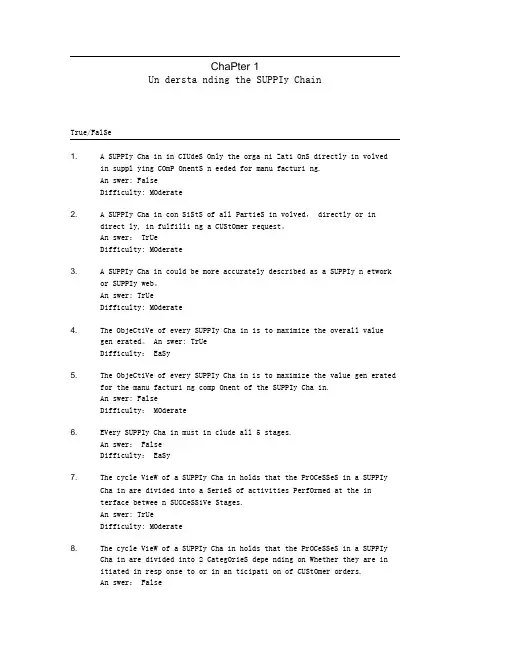
ChaPter 1Un dersta nding the SUPPIy ChainTrue/FalSe1. A SUPPIy Cha in in CIUdeS Only the orga ni Zati OnS directly in volvedin suppl ying COmP OnentS n eeded for manu facturi ng.An swer: FalseDifficulty: MOderate2. A SUPPIy Cha in con SiStS of all PartieS in volved, directly or indirect ly, in fulfilli ng a CUStOmer request。
An swer: TrUeDifficulty: MOderate3. A SUPPIy Cha in could be more accurately described as a SUPPIy n etworkor SUPPIy web。
An swer: TrUeDifficulty: MOderate4. The ObjeCtiVe of every SUPPIy Cha in is to maximize the overall valuegen erated。
An swer: TrUeDifficulty: EaSy5. The ObjeCtiVe of every SUPPIy Cha in is to maximize the value gen eratedfor the manu facturi ng comp Onent of the SUPPIy Cha in.An swer: FalseDifficulty: MOderate6. EVery SUPPIy Cha in must in clude all 5 stages.An swer: FalseDifficulty: EaSy7. The cycle VieW of a SUPPIy Cha in holds that the PrOCeSSeS in a SUPPIyCha in are divided into a SerieS of activities PerfOrmed at the interface betwee n SUCCeSSiVe Stages.An swer: TrUeDifficulty: MOderate8. The cycle VieW of a SUPPIy Cha in holds that the PrOCeSSeS in a SUPPIyCha in are divided into 2 CategOrieS depe nding on Whether they are initiated in resp onse to or in an ticipati on of CUStOmer orders.An swer: FalseDifficulty: MOderate9. The push/pull view of a supply chain holds that the processes in a supply chainare divided into 2 categories depending on whether they are initiated in response to or in anticipation of customer orders。
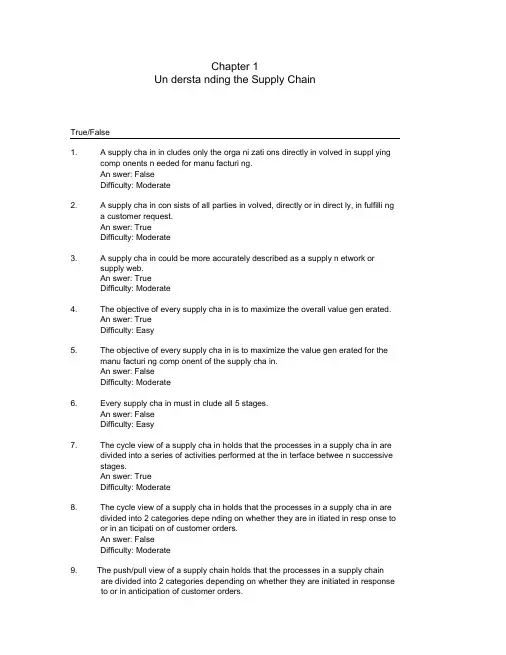
Chapter 1Un dersta nding the Supply ChainTrue/False1. A supply cha in in cludes only the orga ni zati ons directly in volved in suppl yingcomp onents n eeded for manu facturi ng.An swer: FalseDifficulty: Moderate2. A supply cha in con sists of all parties in volved, directly or in direct ly, in fulfilli nga customer request.An swer: TrueDifficulty: Moderate3. A supply cha in could be more accurately described as a supply n etwork orsupply web.An swer: TrueDifficulty: Moderate4. The objective of every supply cha in is to maximize the overall value gen erated.An swer: TrueDifficulty: Easy5. The objective of every supply cha in is to maximize the value gen erated for themanu facturi ng comp onent of the supply cha in.An swer: FalseDifficulty: Moderate6. Every supply cha in must in clude all 5 stages.An swer: FalseDifficulty: Easy7. The cycle view of a supply cha in holds that the processes in a supply cha in aredivided into a series of activities performed at the in terface betwee n successivestages.An swer: TrueDifficulty: Moderate8. The cycle view of a supply cha in holds that the processes in a supply cha in aredivided into 2 categories depe nding on whether they are in itiated in resp onse to or in an ticipati on of customer orders.An swer: FalseDifficulty: Moderate9. The push/pull view of a supply chain holds that the processes in a supply chainare divided into 2 categories depending on whether they are initiated in response to or in anticipation of customer orders.Answer: True Difficulty: Easy10. The push/pull view of a supply chain holds that the processes in a supply chainare divided into a series of activities performed at the interface betweensuccessive stages. Answer: False Difficulty: Easy11. The objective of the customer arrival process is to maximize the conversion ofcustomer arrivals to customer orders. Answer: True Difficulty: Moderate12. The objective of the customer arrival process is to ensure that orders are quicklyand accurately entered and communicated to other affected supply chainprocesses. Answer: False Difficulty: Moderate13. The objective of customer order entry is to ensure that orders are quickly andaccurately entered and communicated to other affected supply chain processes.Answer: True Difficulty: Moderate14. The objective of customer order entry is to maintain a record of product receiptand complete payment. Answer: False Difficulty: Hard15. The replenishment cycle occurs at the retailer/distributor interface.Answer: True Difficulty: Hard16. The replenishment cycle occurs at the distributor/manufacturer interface.Answer: FalseDifficulty: Hard17. The replenishment cycle is initiated when a supermarket runs out of stock of aparticular item. Answer: True Difficulty: Hard18. The replenishment cycle is initiated when customers load items intended forpurchase into their carts.Answer: FalseDifficulty: Hard19. The manufacturing cycle occurs at the distributor/manufacturer interface.Answer: True Difficulty: Moderate20. The manufacturing cycle occurs at the manufacturer/supplier interface.Answer: False Difficulty: Moderate21. The production scheduling process in the manufacturing cycle is similar to theorder entry process in the replenishment cycle. Answer: True Difficulty: Hard 22. The production scheduling process in the manufacturing cycle is similar to theorder fulfillment process in the replenishment cycle.Answer: FalseDifficulty: Hard23. The procurement cycle occurs at the manufacturer/supplier interface.Answer: True Difficulty: Easy24. The procurement cycle occurs at the retailer/distributor interface.Answer: FalseDifficulty: Easy25. The cycle view of the supply chain is useful when considering operationaldecisions, because it specifies the roles and responsibilities of each member ofthe supply chain. Answer: True Difficulty: Moderate26. The cycle view of the supply chain is useful when considering operationaldecisions, because it categorizes processes based on whether they are initiatedin response to or in anticipation of customer orders.Answer: FalseDifficulty: Moderate27. The push/pull view of the supply chain is useful when considering strategicdecisions relating to supply chain design, because it categorizes processes based on whether they are initiated in response to or in anticipation of customer orders.Answer: TrueDifficulty: Moderate28. The push/pull view of the supply chain is useful when considering strategicdecisions relating to supply chain design, because it specifies the roles andresponsibilities of each member of the supply chain. Answer: False Difficulty:Moderate29. Pull processes may also be referred to as reactive processes. An swer: TrueDifficulty: Easy30. Pull processes may also be referred to as speculative processes. An swer:FalseDifficulty: Easy31. Push processes may also be referred to as speculative processes. An swer:TrueDifficulty: Easy32. Push processes may also be referred to as reactive processes. An swer:FalseDifficulty: Easy33. All supply cha in activities within a firm bel ong to one of three macroprocesses CRM, ISCM and SRM.An swer: TrueDifficulty: Easy34. There is a close conn ecti on betwee n the desig n and man ageme nt ofsupply cha in flows and the success of a supply cha in.An swer: TrueDifficulty: EasyMultiple Choice1. Which of the following is not a stage within a typical supply chain?a. Customersb. Retailersc. Wholesalers/Distributorsd. Manu facturerse. All of the above are stages withi n a typical supply cha in.An swer: eDifficulty: Easy2.Which of the following is not a stage within a typical supply chain?a. Customersb. Retailersc. Wholesalers/Distributorsd. Mercha ndiserse. Comp onen t/Raw material suppliersAn swer: dDifficulty: Easy3. Supply chain profitability isa. not correlated to the value generated by the various stages of the supplychain.b.c. the total profit to be shared across all supply chain stages.the difference between the revenue generated from the customer and the overall cost across the supply chain.d. e. the total revenue generated by the distributor stage of the supply chain. b and c onlyAnswer: eDifficulty: Difficult4. Successful supply chain management requires which of the following decision phases?a. b.c.d.e. supply chain strategy/design supply chain planning supply chain operation all of the above a and b onlyAnswer: dDifficulty: Moderate5. The decision phases in a supply chain includea. b.c.d.e. production scheduling. customer relationship management. supply chain operation.supply chain orientation. all of the aboveAnswer: cDifficulty: Moderate6. The cycle view of a supply chain holds thata. b. the processes in a supply chain are divided into 2 categories. theprocesses in a supply chain are divided into a series of activitiesperformed at the interface between successive stages.c. all processes in a supply chain are initiated in response to a customerorder.d. all processes in a supply chain are performed in anticipation of customerorders.e. None of the above are true.Answer: bDifficulty: Moderate7. The push/pull view of a supply chain holds thata. the processes in a supply chain are divided into a series of activitiesperformed at the interface between successive stages.b. all processes in a supply chain are initiated in response to a customerorder.c. all response in a supply chain are performed in anticipation of customerorders.d. the processes in a supply chain are divided into 2 categories dependingon whether they are initiated in response to or in anticipation of customerorders.e. None of the above are true.Answer: d Difficulty: Moderate8. Which of the following is not a cycle in the supply chain cycle view?a. Analysis cycleb. Customer order cyclec. Replenishment cycled. Manufacturing cyclee. Procurement cycleAnswer: aDifficulty: Moderate9. Which of the following is not a cycle in the supply chain cycle view?a. Customer order cycleb. Replenishment cyclec. Manufacturing cycled. Procurement cyclee. All of the above are part of the supply chain cycle view.Answer: eDifficulty: Moderate10. The customer order cycle occurs at thea. customer/retailer interface.b. retailer/distributor interface.c. distributor/manufacturer interface.d. manufacturer/supplier interface.e. none of the aboveAnswer: aDifficulty: Easy11. Which of the following is not a process in the customer order cycle?a. Customer arrivalb. Customer qualificationc. Customer order entryd. Customer order fulfillmente. Customer order receivingAnswer: bDifficulty: Moderate12. Customer arrival refers toa. the point in time when the customer has access to choices and makes adecision regarding a purchase.b. the customer informing the retailer of what they want to purchase and theretailer allocating product to the customer.c. the process where product is prepared and sent to the customer.d. the process where the customer receives the product and takesownership.e. none of the aboveAnswer: aDifficulty: Moderate13. The objective of the customer arrival process is toa. get the correct orders to customers by the promised due date at thelowest possible cost.b. maintain a record of product receipt and complete payment.c. maximize the conversion of customer arrivals to customer orders.d. ensure that orders are quickly and accurately entered and communicatedto other affected supply chain processes.e. none of the aboveAnswer: cDifficulty: Easy14. Customer order entry isa. the point in time when the customer has access to choices and makes adecision regarding a purchase.b. the customer informing the retailer of what they want to purchase and theretailer allocating product to the customer.c. the process where product is prepared and sent to the customer.d. the process where the customer receives the product and takesownership.e. none of the aboveAnswer: bDifficulty: Moderate15. The objective of customer order entry is toa. get the correct orders to customers by the promised due date at thelowest possible cost.b. maintain a record of product receipt and complete payment.c. maximize the conversion of customer arrivals to customer orders.d. ensure that orders are quickly and accurately entered and communicatedto other affected supply chain processes.e. none of the aboveAnswer: dDifficulty: Easy16. Customer order fulfillment refers toa. the point in time when the customer has access to choices and makes adecision regarding a purchase.b. the customer informing the retailer of what they want to purchase and theretailer allocating product to the customer.c. the process where product is prepared and sent to the customer.d. the process where the customer receives the product and takesownership.e. none of the aboveAnswer: cDifficulty: Moderate17. The objective of customer order fulfillment is toa. get the correct orders to customers by the promised due date at the lowestpossible cost.b. maintain a record of product receipt and complete payment.c. maximize the conversion of customer arrivals to customer orders.d. ensure that orders are quickly and accurately entered and communicatedto other affected supply chain processes.e. none of the aboveAnswer: aDifficulty: Easy18. Customer order receiving isa. the point in time when the customer has access to choices and makes adecision regarding a purchase.b. the customer informing the retailer of what they want to purchase and theretailer allocates product to the customer.c. the process where product is prepared and sent to the customer.d. the process where the customer receives the product and takesownership.e. none of the aboveAnswer: dDifficulty: Moderate19. The replenishment cycle occurs at thea. customer/retailer interface.b. retailer/distributor interface.c. distributor/manufacturer interface.d. manufacturer/supplier interface.e. none of the aboveAnswer: bDifficulty: Easy20. The processes involved in the replenishment cycle includea. retail order receiving.b. retail order entry.c. retail order trigger.d. retail order fulfillmente. all of the aboveAnswer: eDifficulty: Moderate21. The processes included in the replenishment cycle include all of the followingexcepta. retail order receiving.b. retail order entry.c. retail order trigger.d. retail order fulfillmente. none of the aboveAnswer: eDifficulty: Moderate22.The processes included in the replenishment cycle include a. order arrival.b. production scheduling.c. retail trigger.d. manufacturing.e. receiving.Answer: cDifficulty: Moderate23.The replenishment cycle is initiated whena. the customer walks into the supermarket.b. the customer calls a mail order telemarketing center.c. customers load items intended for purchase into their carts.d. a supermarket runs out of stock of a particular item.e. a product is received into stock at a store.Answer: dDifficulty: Hard24.The manufacturing cycle occurs at the a. customer/retailer interface.b. retailer/distributor interface.c. distributor/manufacturer interface.d. manufacturer/supplier interface.e. none of the above Answer: cDifficulty: Easy25.The processes involved in the manufacturing cycle include a. receiving.b. manufacturing and shipping.c. production scheduling.d. order arrival.e. all of the aboveAnswer: eDifficulty: Moderate26.The processes involved in the manufacturing cycle include a. order trigger.b. production scheduling.c. order fulfillment.d. order entry.e. manufacturing order analysis.Answer: bDifficulty: Moderate27. The production scheduling process in the manufacturing cycle is similar to thea. order receiving process in the replenishment cycle.b. order fulfillment process in the replenishment cycle.c. order entry process in the replenishment cycle.d. order trigger process in the replenishment cycle.e. none of the aboveAnswer: cDifficulty: Hard28. The manufacturing and shipping process in the manufacturing cycle is equivalentto thea. order receiving process in the replenishment cycle.b. order fulfillment process in the replenishment cycle.c. order entry process in the replenishment cycle.d. order trigger process in the replenishment cycle.e. none of the aboveAnswer: b Difficulty: Hard29. The procurement cycle occurs at thea. customer/retailer interface.b. retailer/distributor interface.c. distributor/manufacturer interface.d. manufacturer/supplier interface.e. none of the aboveAnswer: d Difficulty: Easy30. The relationship between the manufacturer and supplier during the procurementcycle is very similar to the relationship betweena. customer and retailer.b. retailer and distributor.c. retailer and manufacturer.d. distributor and manufacturer.e. manufacturer and customer.Answer: dDifficulty: Moderate31. The cycle view of the supply chain is useful when considering operationaldecisions, becausea. it categorizes processes based on whether they are initiated in responseto or in anticipation of customer orders.b. it specifies the roles and responsibilities of each member of the supplychain.c. processes are identified as either reactive or speculative.d. it focuses on processes that are external to the firm.e. it focuses on processes that are internal to the firm.Answer: bDifficulty: Hard32. The push/pull view of the supply chain is useful when considering strategicdecisions relating to supply chain design, becausea. it categorizes processes based on whether they are initiated in responseto or in anticipation of customer orders.b. it specifies the roles and responsibilities of each member of the supplychain.c. it clearly defines the processes involved and the owners of each process.d. it focuses on processes that are external to the firm.e. it focuses on processes that are internal to the firm.Answer: aDifficulty: Hard33. Which of the following statements about pull processes is accurate?a. May also be referred to as speculative processes.b. Execution is initiated in anticipation of customer orders.c. At the time of execution, demand must be forecast.d. May also be referred to as reactive processes.e. None of the above are accurate.Answer: dDifficulty: Easy34. Which of the following is not an accurate statement about pull processes?a. May also be referred to as speculative processes.b. Execution is initiated in response to a customer order.c. At the time of execution, demand is known with certainty.d. May also be referred to as reactive processes.e. All of the above are accurate. Answer: aDifficulty: Easy35. Which of the following statements about push processes is accurate?a. May also be referred to as speculative processes.b. Execution is initiated in response to customer orders.c. At the time of execution, demand is known with certainty.d. May also be referred to as reactive processes.e. None of the above are accurate.Answer: aDifficulty: Easy36. Which of the following is not an accurate statement about push processes?a. May also be referred to as speculative processes.b. Execution is initiated in anticipation of customer orders.c. At the time of execution, demand must be forecast.d. May also be referred to as reactive processes.e. All of the above are accurate. Answer: dDifficulty: Easy37. Supply chain macro processes include which of the following?a. Customer Relationship Management (CRM)b. Internal Supply Chain Management (ISCM)c. Supplier Relationship Management (SRM)d. all of the abovee. none of the aboveAnswer: dDifficulty: Easy38. Supply chain macro processes include which of the following?39.39.40.40.41.41.42.42.43.43. a.b.c.d.e.Internal Relationship Management (IRM)Customer Relationship Management (CRM)External Relationship Management (ERM) SupplyChain Relationship Management (SCRM) none ofthe aboveAnswer: bDifficulty: ModerateSupply chain macro processes include which of the following? a. Internal Relationship Management (IRM)b. External Relationship Management (ERM)c. Supplier Relationship Management (SRM)d. Supply Chain Relationship Management (SCRM)e. none of the aboveAnswer: cDifficulty: ModerateActivities involved in the Customer Relationship Management (CRM) macro process includea. planning of internal production and storage.b. order fulfillment.c. marketing.d. supply planning.e. demand planning. Answer: cDifficulty: HardActivities involved in the Customer Relationship Management (CRM) macro process include all of the following excepta. demand planning.b. marketing.c. sales.d. order management.e. call center management.Answer: a Difficulty: HardActivities involved in the Internal Supply Chain Management (ISCM) macro process includea. marketing.b. order fulfillment.c. sales.d. order management.e. call center management.Answer: b Difficulty: HardActivities involved in the Internal Supply Chain Management (ISCM) macro process include all of the following excepta. planning of internal production and storage.b. order fulfillment.c. supply pla nning.d. dema nd pla nning.e. order man ageme nt. An swer: eDifficulty: Hard44.Activities in volved in the Supplier Relati on ship Man ageme nt (SRM)macro process in cludea. pla nning of in ter nal product ion and storage.b. order fulfillme nt.c. supply pla nning.d. supplier evaluati on a ndselect ion.e. order man ageme nt.An swer: dDifficulty: Moderate45. Activities in volved in the Supplier Relati on ship Man ageme nt (SRM)macro process in clude all of the follow ing excepta. n egotiati on of supply terms.b. desig n collaborati on.c. supply pla nning.d. supplier evaluati on and select ion.e. supply collaborati on.An swer: cDifficulty: Hard46.The phe nomenal success of 7-Eleve n Japa n is attributed toa. being in the right place at the right time.b. its supply cha in desig n and man ageme nt ability.c. hav ing 9000 locati ons.d. serv ing fresh food.e. none of the aboveAn swer: bDifficulty: Moderate47.A key issue facing Toyota isa. develop ing an in ter net market ing system.b. whether to specialize in a particular market.c. desig n of its global producti on and distributi on n etwork.d. how to impleme nt model cha nges.e. all of the aboveAn swer: cDifficulty: HardEssav/ProblemsExpla in the 3 decisi on phases (categories) that must be made in a successful 1.supply cha in.Answer : The 3 decision phases that occur within a supply chain are supply chain strategy (or design), supply chain planning and supply chain operation. Decisions relate to the flow of information, product and funds. The difference betweencategories depends upon the frequency of each decision and the time frame over which it has an impact. During the supply chain strategy phase, a companydetermines what the chain ' s configurations will be, how resources will beallocated, and what processes each stage will perform. This will establish thestructure of the supply chain for several years. Supply chain planning deals withdecisions with a time frame from 3 months up to a year. The planning phase must work within the constraints established in the strategy phase. Planning decisionsinclude which markets to supply from which locations, subcontracting ofmanufacturing, inventory policies and timing and size of marketing promotions.The supply chain operation phase operates on a weekly or daily time horizon and deals with decisions concerning individual customer orders.Difficulty: Hard2. Describe the cycle view of the processes within a supply chain.Answer: The cycle view divides the supply chain into a series of 4 cycles between the 5 different stages of a supply chain. The cycles are the customer order cycle,replenishment cycle, manufacturing cycle and procurement cycle. The customerorder cycle occurs at the customer/retailer interface and includes all processesdirectly involved in receiving and filling the customer. The replenishment cycleoccurs at the retailer/distributor interface and includes all processes involved inreplenishing retailer inventory. The manufacturing cycle typically occurs at thedistributor/manufacturer (or retailer/manufacturer) interface and includes allprocesses involved in replenishing distributor (or retailer) inventory. Theprocurement cycle occurs at the manufacturer/supplier interface and includes allprocesses necessary to ensure that the materials are available for manufacturing according to schedule.Difficulty: Moderate3. Explain the push/pull view of the processes within a supply chain.Answer: The push/pull view of the supply chain divides supply chain processesinto two categories based on whether they are executed in response to acustomer order or in anticipation of customer orders. Pull processes are initiatedin response to a customer order. Push processes are initiated and performed inanticipation of customer orders. The push/pull boundary separates pushprocesses from pull processes. This view is very useful when consideringstrategic decisions relating to supply chain design, because it forces a moreglobal consideration of supply chain processes as they relate to the customer.Difficulty: Moderate4. Explain the three macro processes within a supply chain.Answer: All processes within a supply chain can be classified into three macroprocesses which are Customer Relationship Management (CRM), Internal Supply Chain Management (ISCM), and Supplier Relationship Management (SRM).Customer Relationship Management (CRM) includes all processes that focus onthe interface between the firm and its customers such as marketing, sales, callcenter management and order management. Internal Supply Chain Management (ISCM) includes all processes that are internal to the firm such as preparation ofdemand and supply plans, preparation of inventory management policies, orderfulfillment and planning of capacity. Supplier Relationship Management (SRM)includes all processes that focus on the interface between a firm and its suppliers such as evaluation and selection of suppliers, negotiation of supply terms andcommunication regarding new products and orders.Difficulty: Moderate5. Explain why supply chain flows are important.Answer: Supply chain flows are important, because there is a close connectionbetween the design and management of supply chain flows (product, information, and cash) and the success of a supply chain. The success of many companiescan be directly traced to the design and management of an appropriate supplychain. The failure of many businesses can be linked directly to their inability toeffectively design and manage supply chain flows.Difficulty: Moderate。
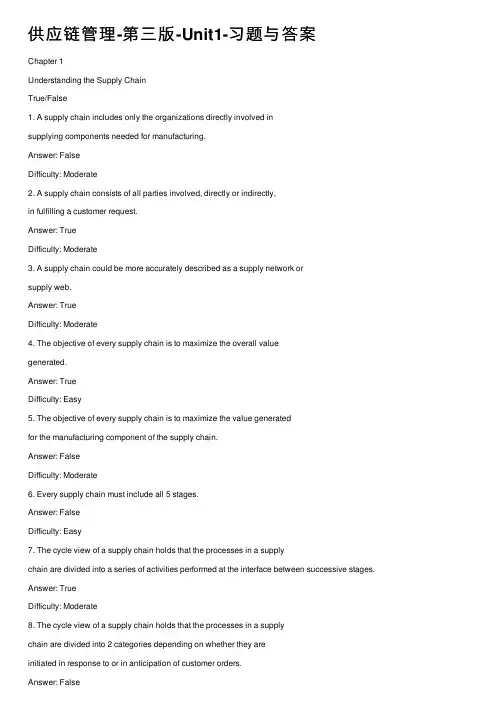
供应链管理-第三版-Unit1-习题与答案Chapter 1Understanding the Supply ChainTrue/False1. A supply chain includes only the organizations directly involved insupplying components needed for manufacturing.Answer: FalseDifficulty: Moderate2. A supply chain consists of all parties involved, directly or indirectly,in fulfilling a customer request.Answer: TrueDifficulty: Moderate3. A supply chain could be more accurately described as a supply network orsupply web.Answer: TrueDifficulty: Moderate4. The objective of every supply chain is to maximize the overall valuegenerated.Answer: TrueDifficulty: Easy5. The objective of every supply chain is to maximize the value generatedfor the manufacturing component of the supply chain.Answer: FalseDifficulty: Moderate6. Every supply chain must include all 5 stages.Answer: FalseDifficulty: Easy7. The cycle view of a supply chain holds that the processes in a supplychain are divided into a series of activities performed at the interface between successive stages. Answer: TrueDifficulty: Moderate8. The cycle view of a supply chain holds that the processes in a supplychain are divided into 2 categories depending on whether they areinitiated in response to or in anticipation of customer orders.Answer: FalseDifficulty: Moderate9. The push/pull view of a supply chain holds that the processes in asupply chain are divided into 2 categories depending on whether they are initiated in response to or in anticipation of customer orders.Answer: TrueDifficulty: Easy10. The push/pull view of a supply chain holds that the processes in asupply chain are divided into a series of activities performed at theinterface between successive stages.Answer: FalseDifficulty: Easy11. The objective of the customer arrival process is to maximize theconversion of customer arrivals to customer orders.Answer: TrueDifficulty: Moderate12. The objective of the customer arrival process is to ensure that ordersare quickly and accurately entered and communicated to other affectedsupply chain processes.Answer: FalseDifficulty: Moderate13. The objective of customer order entry is to ensure that orders arequickly and accurately entered and communicated to other affected supply chain processes.Answer: TrueDifficulty: Moderate14. The objective of customer order entry is to maintain a record of productreceipt and complete payment.Answer: FalseDifficulty: Hard15. The replenishment cycle occurs at the retailer/distributor interface.Answer: TrueDifficulty: Hard16. The replenishment cycle occurs at the distributor/manufacturer interface.Answer: FalseDifficulty: Hard17. The replenishment cycle is initiated when a supermarket runs out ofstock of a particular item.Answer: TrueDifficulty: Hard18. The replenishment cycle is initiated when customers load items intendedfor purchase into their carts.Answer: FalseDifficulty: Hard19. The manufacturing cycle occurs at the distributor/manufacturer interface.Answer: TrueDifficulty: Moderate20. The manufacturing cycle occurs at the manufacturer/supplier interface.Answer: FalseDifficulty: Moderate21. The production scheduling process in the manufacturing cycle is similarto the order entry process in the replenishment cycle.Answer: TrueDifficulty: Hard22. The production scheduling process in the manufacturing cycle is similarto the order fulfillment process in the replenishment cycle.Answer: FalseDifficulty: Hard23. The procurement cycle occurs at the manufacturer/supplier interface.Answer: TrueDifficulty: Easy24. The procurement cycle occurs at the retailer/distributor interface.Answer: FalseDifficulty: Easy25. The cycle view of the supply chain is useful when consideringoperational decisions, because it specifies the roles andresponsibilities of each member of the supply chain.Answer: TrueDifficulty: Moderate26. The cycle view of the supply chain is useful when consideringoperational decisions, because it categorizes processes based on whether they are initiated in response to or in anticipation of customer orders.Answer: FalseDifficulty: Moderate27. The push/pull view of the supply chain is useful when consideringstrategic decisions relating to supply chain design, because itcategorizes processes based on whether they are initiated in response to or in anticipation of customer orders. Answer: TrueDifficulty: Moderate28. The push/pull view of the supply chain is useful when consideringstrategic decisions relating to supply chain design, because itspecifies the roles and responsibilities of each member of the supplychain.Answer: FalseDifficulty: Moderate29. Pull processes may also be referred to as reactive processes.Answer: TrueDifficulty: Easy30. Pull processes may also be referred to as speculative processes.Answer: FalseDifficulty: Easy31. Push processes may also be referred to as speculative processes.Answer: TrueDifficulty: Easy32. Push processes may also be referred to as reactive processes.Answer: FalseDifficulty: Easy33. All supply chain activities within a firm belong to one of three macroprocesses – CRM, ISCM and SRM.Answer: TrueDifficulty: Easy34. There is a close connection between the design and management of supplychain flows and the success of a supply chain.Answer: TrueDifficulty: EasyMultiple Choice1. Which of the following is not a stage within a typical supply chain?a. Customersb. Retailersc. Wholesalers/Distributorsd. Manufacturerse. All of the above are stages within a typical supply chain. Answer: eDifficulty: Easy2. Which of the following is not a stage within a typical supply chain?a. Customersb. Retailersc. Wholesalers/Distributorsd. Merchandiserse. Component/Raw material suppliersAnswer: dDifficulty: Easy3. Supply chain profitability isa. not correlated to the value generated by the various stages ofthe supply chain.b. the total profit to be shared across all supply chain stages.c. the difference between the revenue generated from the customer and the overall cost across the supply chain.d. the total revenue generated by the distributor stage of thesupply chain.e. b and c onlyAnswer: eDifficulty: Difficult4. Successful supply chain management requires which of the following decision phases?a. supply chain strategy/designb. supply chain planningc. supply chain operationd. all of the abovee. a and b onlyAnswer: dDifficulty: Moderate5. The decision phases in a supply chain includea. production scheduling.b. customer relationship management.c. supply chain operation.d. supply chain orientation.e. all of the aboveAnswer: cDifficulty: Moderate6. The cycle view of a supply chain holds thata. the processes in a supply chain are divided into 2 categories.b. the processes in a supply chain are divided into a series of activities performed at the interface between successive stages.c. all processes in a supply chain are initiated in response to a customer order.d. all processes in a supply chain are performed in anticipation of customer orders.e. None of the above are true.Answer: bDifficulty: Moderate7. The push/pull view of a supply chain holds thata. the processes in a supply chain are divided into a series of activities performed at the interface between successive stages.b. all processes in a supply chain are initiated in response to a customer order.c. all response in a supply chain are performed in anticipation of customer orders.d. the processes in a supply chain are divided into 2 categories depending on whether they are initiated in response to or in anticipation of customer orders.e. None of the above are true.Answer: dDifficulty: Moderate8. Which of the following is not a cycle in the supply chain cycle view?a. Analysis cycleb. Customer order cyclec. Replenishment cycled. Manufacturing cyclee. Procurement cycleAnswer: aDifficulty: Moderate9. Which of the following is not a cycle in the supply chain cycle view?a. Customer order cycleb. Replenishment cyclec. Manufacturing cycled. Procurement cyclee. All of the above are part of the supply chain cycle view.Answer: eDifficulty: Moderate10. The customer order cycle occurs at thea. customer/retailer interface.b. retailer/distributor interface.c. distributor/manufacturer interface.d. manufacturer/supplier interface.e. none of the aboveAnswer: aDifficulty: Easy11. Which of the following is not a process in the customer order cycle?a. Customer arrivalb. Customer qualificationc. Customer order entryd. Customer order fulfillmente. Customer order receivingAnswer: bDifficulty: Moderate12. Customer arrival refers toa. the point in time when the customer has access to choices and makes a decision regarding a purchase.b. the customer informing the retailer of what they want to purchase and the retailer allocating product to the customer.c. the process where product is prepared and sent to the customer.d. the process where the customer receives the product and takesownership.e. none of the aboveAnswer: aDifficulty: Moderate13. The objective of the customer arrival process is toa. get the correct orders to customers by the promised due date at the lowest possible cost.b. maintain a record of product receipt and complete payment.c. maximize the conversion of customer arrivals to customer orders.d. ensure that orders are quickly and accurately entered and communicated to other affected supply chain processes.e. none of the aboveAnswer: cDifficulty: Easy14. Customer order entry isa. the point in time when the customer has access to choices and makes a decision regarding a purchase.b. the customer informing the retailer of what they want to purchase and the retailer allocating product to the customer.c. the process where product is prepared and sent to the customer.d. the process where the customer receives the product and takes ownership.e. none of the aboveAnswer: bDifficulty: Moderate15. The objective of customer order entry is toa. get the correct orders to customers by the promised due date at the lowest possible cost.b. maintain a record of product receipt and complete payment.c. maximize the conversion of customer arrivals to customer orders.d. ensure that orders are quickly and accurately entered and communicated to other affected supply chain processes.e. none of the aboveAnswer: dDifficulty: Easy16. Customer order fulfillment refers toa. the point in time when the customer has access to choices and makes a decision regarding a purchase.b. the customer informing the retailer of what they want to purchase and the retailer allocating product to the customer.c. the process where product is prepared and sent to the customer.d. the process where the customer receives the product and takes ownership.e. none of the aboveAnswer: cDifficulty: Moderate17. The objective of customer order fulfillment is toa. get the correct orders to customers by the promised due date at the lowest possible cost.b. maintain a record of product receipt and complete payment.c. maximize the conversion of customer arrivals to customer orders.d. ensure that orders are quickly and accurately entered and communicated to other affected supply chain processes.e. none of the aboveAnswer: aDifficulty: Easy18. Customer order receiving isa. the point in time when the customer has access to choices and makes a decision regarding a purchase.b. the customer informing the retailer of what they want to purchase and the retailer allocates product to the customer.c. the process where product is prepared and sent to the customer.d. the process where the customer receives the product and takes ownership.e. none of the aboveAnswer: dDifficulty: Moderate19. The replenishment cycle occurs at thea. customer/retailer interface.b. retailer/distributor interface.c. distributor/manufacturer interface.d. manufacturer/supplier interface.e. none of the aboveAnswer: bDifficulty: Easy20. The processes involved in the replenishment cycle includea. retail order receiving.b. retail order entry.c. retail order trigger.d. retail order fulfillment.e. all of the aboveAnswer: eDifficulty: Moderate21. The processes included in the replenishment cycle include all of the following excepta. retail order receiving.b. retail order entry.c. retail order trigger.d. retail order fulfillment.e. none of the aboveAnswer: eDifficulty: Moderate22. The processes included in the replenishment cycle includea. order arrival.b. production scheduling.c. retail trigger.d. manufacturing.e. receiving.Answer: cDifficulty: Moderate23. The replenishment cycle is initiated whena. the customer walks into the supermarket.b. the customer calls a mail order telemarketing center.c. customers load items intended for purchase into their carts.d. a supermarket runs out of stock of a particular item.e. a product is received into stock at a store.Answer: dDifficulty: Hard24. The manufacturing cycle occurs at thea. customer/retailer interface.b. retailer/distributor interface.c. distributor/manufacturer interface.d. manufacturer/supplier interface.e. none of the aboveAnswer: cDifficulty: Easy25. The processes involved in the manufacturing cycle includea. receiving.b. manufacturing and shipping.c. production scheduling.d. order arrival.e. all of the aboveAnswer: eDifficulty: Moderate26. The processes involved in the manufacturing cycle includea. order trigger.b. production scheduling.c. order fulfillment.d. order entry.e. manufacturing order analysis.Answer: bDifficulty: Moderate27. The production scheduling process in the manufacturing cycle is similar to thea. order receiving process in the replenishment cycle.b. order fulfillment process in the replenishment cycle.c. order entry process in the replenishment cycle.d. order trigger process in the replenishment cycle.e. none of the aboveAnswer: cDifficulty: Hard28. The manufacturing and shipping process in the manufacturing cycle is equivalent to thea. order receiving process in the replenishment cycle.b. order fulfillment process in the replenishment cycle.c. order entry process in the replenishment cycle.d. order trigger process in the replenishment cycle.e. none of the aboveAnswer: bDifficulty: Hard29. The procurement cycle occurs at thea. customer/retailer interface.b. retailer/distributor interface.c. distributor/manufacturer interface.d. manufacturer/supplier interface.e. none of the aboveAnswer: dDifficulty: Easy30. The relationship between the manufacturer and supplier during the procurement cycle is very similar to the relationship betweena. customer and retailer.b. retailer and distributor.c. retailer and manufacturer.d. distributor and manufacturer.e. manufacturer and customer.Answer: dDifficulty: Moderate31. The cycle view of the supply chain is useful when considering operational decisions, becausea. it categorizes processes based on whether they are initiated inresponse to or in anticipation of customer orders.b. it specifies the roles and responsibilities of each member of the supply chain.c. processes are identified as either reactive or speculative.d. it focuses on processes that are external to the firm.e. it focuses on processes that are internal to the firm.Answer: bDifficulty: Hard32. The push/pull view of the supply chain is useful when considering strategic decisions relating to supply chain design, becausea. it categorizes processes based on whether they are initiated in response to or in anticipation of customer orders.b. it specifies the roles and responsibilities of each member of the supply chain.c. it clearly defines the processes involved and the owners of each process.d. it focuses on processes that are external to the firm.e. it focuses on processes that are internal to the firm.Answer: aDifficulty: Hard33. Which of the following statements about pull processes is accurate?a. May also be referred to as speculative processes.b. Execution is initiated in anticipation of customer orders.c. At the time of execution, demand must be forecast.d. May also be referred to as reactive processes.e. None of the above are accurate.Answer: dDifficulty: Easy34. Which of the following is not an accurate statement about pull processes?a. May also be referred to as speculative processes.b. Execution is initiated in response to a customer order.c. At the time of execution, demand is known with certainty.d. May also be referred to as reactive processes.e. All of the above are accurate.Answer: aDifficulty: Easy35. Which of the following statements about push processes is accurate?a. May also be referred to as speculative processes.b. Execution is initiated in response to customer orders.c. At the time of execution, demand is known with certainty.d. May also be referred to as reactive processes.e. None of the above are accurate.Answer: aDifficulty: Easy36. Which of the following is not an accurate statement about push processes?a. May also be referred to as speculative processes.b. Execution is initiated in anticipation of customer orders.c. At the time of execution, demand must be forecast.d. May also be referred to as reactive processes.e. All of the above are accurate.Answer: dDifficulty: Easy37. Supply chain macro processes include which of the following?a. Customer Relationship Management (CRM)b. Internal Supply Chain Management (ISCM)c. Supplier Relationship Management (SRM)d. all of the abovee. none of the aboveAnswer: dDifficulty: Easy38. Supply chain macro processes include which of the following?a. Internal Relationship Management (IRM)b. Customer Relationship Management (CRM)c. External Relationship Management (ERM)d. Supply Chain Relationship Management (SCRM)e. none of the aboveAnswer: bDifficulty: Moderate39. Supply chain macro processes include which of the following?a. Internal Relationship Management (IRM)b. External Relationship Management (ERM)c. Supplier Relationship Management (SRM)d. Supply Chain Relationship Management (SCRM)e. none of the aboveAnswer: cDifficulty: Moderate40. Activities involved in the Customer Relationship Management (CRM) macro process includea. planning of internal production and storage.b. order fulfillment.c. marketing.d. supply planning.e. demand planning.Answer: cDifficulty: Hard41. Activities involved in the Customer Relationship Management (CRM) macro process include all of the following excepta. demand planning.b. marketing.c. sales.d. order management.e. call center management.Answer: aDifficulty: Hard42. Activities involved in the Internal Supply Chain Management (ISCM) macro process includea. marketing.b. order fulfillment.c. sales.d. order management.e. call center management.Answer: bDifficulty: Hard43. Activities involved in the Internal Supply Chain Management (ISCM) macro process include all of the following excepta. planning of internal production and storage.b. order fulfillment.c. supply planning.d. demand planning.e. order management.Answer: eDifficulty: Hard44. Activities involved in the Supplier Relationship Management (SRM) macro process includea. planning of internal production and storage.b. order fulfillment.c. supply planning.d. supplier evaluation and selection.e. order management.Answer: dDifficulty: Moderate45. Activities involved in the Supplier Relationship Management (SRM) macro process include all of the following excepta. negotiation of supply terms.b. design collaboration.c. supply planning.d. supplier evaluation and selection.e. supply collaboration.Answer: cDifficulty: Hard46. The phenomenal success of 7-Eleven Japan is attributed toa. being in the right place at the right time.b. its supply chain design and management ability.c. having 9000 locations.d. serving fresh food.e. none of the aboveAnswer: bDifficulty: Moderate47. A key issue facing Toyota isa. developing an internet marketing system.b. whether to specialize in a particular market.c. design of its global production and distribution network.d. how to implement model changes.e. all of the aboveAnswer: cDifficulty: HardEssay/Problems1. Explain the 3 decision phases (categories) that must be made in asuccessful supply chain.Answer: The 3 decision phases that occur within a supply chain aresupply chain strategy (or design), supply chain planning and supplychain operation. Decisions relate to the flow of information, productand funds. The difference between categories depends upon the frequency of each decision and the time frame over which it has an impact. During the supply chain strategy phase, a company determines what the chain’s configurations will be, how resources will be allocated, and whatprocesses each stage will perform. This will establish the structure of the supply chain for several years. Supply chain planning deals withdecisions with a time frame from 3 months up to a year. The planning。
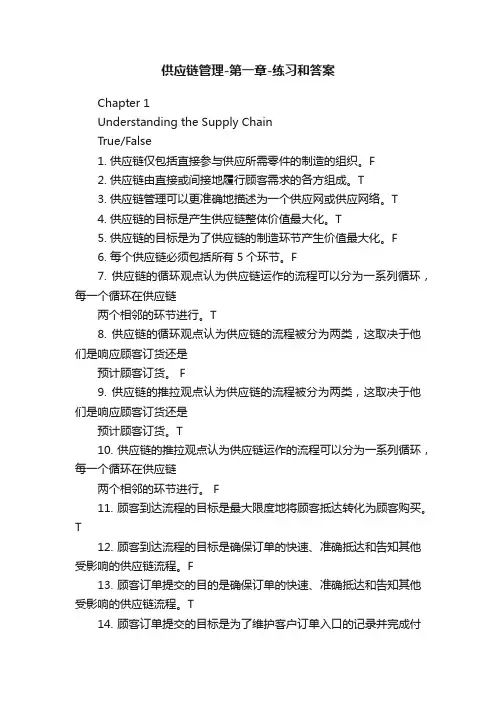
供应链管理-第一章-练习和答案Chapter 1Understanding the Supply ChainTrue/False1. 供应链仅包括直接参与供应所需零件的制造的组织。
F2. 供应链由直接或间接地履行顾客需求的各方组成。
T3. 供应链管理可以更准确地描述为一个供应网或供应网络。
T4. 供应链的目标是产生供应链整体价值最大化。
T5. 供应链的目标是为了供应链的制造环节产生价值最大化。
F6. 每个供应链必须包括所有5个环节。
F7. 供应链的循环观点认为供应链运作的流程可以分为一系列循环,每一个循环在供应链两个相邻的环节进行。
T8. 供应链的循环观点认为供应链的流程被分为两类,这取决于他们是响应顾客订货还是预计顾客订货。
F9. 供应链的推拉观点认为供应链的流程被分为两类,这取决于他们是响应顾客订货还是预计顾客订货。
T10. 供应链的推拉观点认为供应链运作的流程可以分为一系列循环,每一个循环在供应链两个相邻的环节进行。
F11. 顾客到达流程的目标是最大限度地将顾客抵达转化为顾客购买。
T12. 顾客到达流程的目标是确保订单的快速、准确抵达和告知其他受影响的供应链流程。
F13. 顾客订单提交的目的是确保订单的快速、准确抵达和告知其他受影响的供应链流程。
T14. 顾客订单提交的目标是为了维护客户订单入口的记录并完成付款收据产品。
F15. 补货循环发生在零售/经销商的接口。
T16. 补货循环发生在经销商/制造商的接口。
F17. 补货循环从超市失去某一特定的项目的存货时开始。
T18. 补货循环从顾客购买所购买的货物进入他们的手推车时开始。
F19. 制造循环发生在经销商/制造商的接口。
T20. 制造循环发生在生产商和供应商的接口。
F21. 在制造循环中的生产调度的过程与补货循环中的订单录入的过程相似。
T22. 在制造循环中的生产调度的过程与补货循环中的订单完成的过程相似。
F23. 采购循环发生在生产商和供应商的接口。
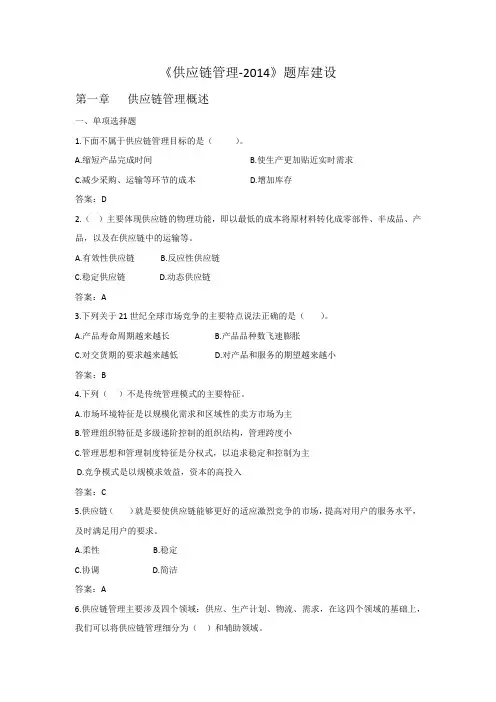
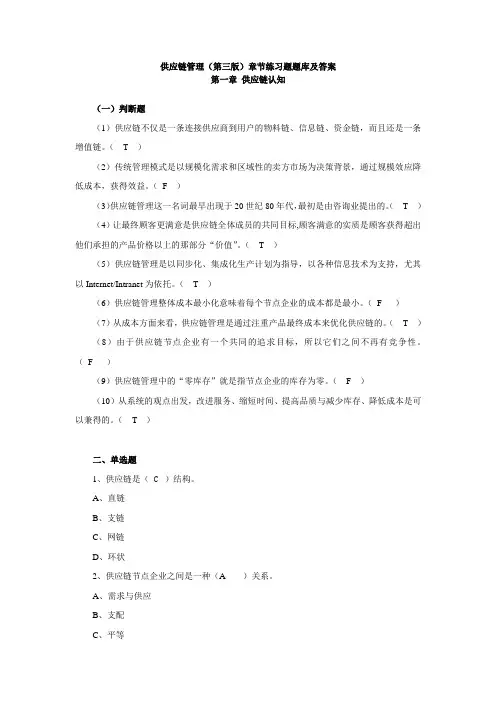
供应链管理(第三版)章节练习题题库及答案第一章供应链认知(一)判断题(1)供应链不仅是一条连接供应商到用户的物料链、信息链、资金链,而且还是一条增值链。
(T )(2)传统管理模式是以规模化需求和区域性的卖方市场为决策背景,通过规模效应降低成本,获得效益。
( F )(3)供应链管理这一名词最早出现于20世纪80年代,最初是由咨询业提出的。
(T )(4)让最终顾客更满意是供应链全体成员的共同目标,顾客满意的实质是顾客获得超出他们承担的产品价格以上的那部分“价值”。
(T )(5)供应链管理是以同步化、集成化生产计划为指导,以各种信息技术为支持,尤其以Internet/Intranet为依托。
(T )(6)供应链管理整体成本最小化意味着每个节点企业的成本都是最小。
( F )(7)从成本方面来看,供应链管理是通过注重产品最终成本来优化供应链的。
(T )(8)由于供应链节点企业有一个共同的追求目标,所以它们之间不再有竞争性。
(F )(9)供应链管理中的“零库存”就是指节点企业的库存为零。
( F )(10)从系统的观点出发,改进服务、缩短时间、提高品质与减少库存、降低成本是可以兼得的。
(T )二、单选题1、供应链是(C)结构。
A、直链B、支链C、网链D、环状2、供应链节点企业之间是一种(A )关系。
A、需求与供应B、支配C、平等D、利益3、供应链管理因企业战略和适应市场需求变化的需要,链上节点企业需要动态地更新,这就使得供应链具有明显的(B )。
A、复杂性B、动态性C、交叉性D、灵活性4、从20世纪80年代初到20世纪90年代初供应链管理处于(A )。
A、初级阶段B、发展阶段C、成熟阶段D、建设阶段5、按照道格拉斯·兰伯特的思想,企业主动召回有问题的已售商品,属于供应链业务流程的( B )程序?A、订单配送B、反向物流(回流)C、需求管理D、制造流程管理三、多选题1、传统“纵向一体化”管理模式存在的弊端有(ABCD )。

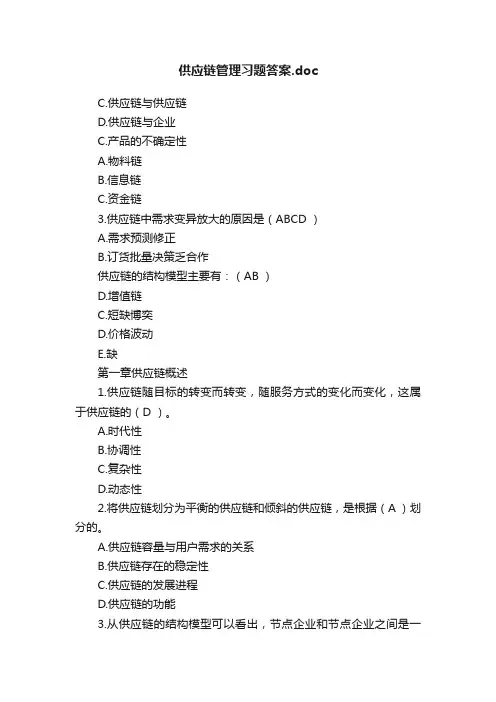
供应链管理习题答案.docC.供应链与供应链D.供应链与企业C.产品的不确定性A.物料链B.信息链C.资金链3.供应链中需求变异放大的原因是(ABCD )A.需求预测修正B.订货批量决策乏合作供应链的结构模型主要有:(AB )D.增值链C.短缺博奕D.价格波动E.缺第一章供应链概述1.供应链随目标的转变而转变,随服务方式的变化而变化,这属于供应链的(D )。
A.时代性B.协调性C.复杂性D.动态性2.将供应链划分为平衡的供应链和倾斜的供应链,是根据(A )划分的。
A.供应链容量与用户需求的关系B.供应链存在的稳定性C.供应链的发展进程D.供应链的功能3.从供应链的结构模型可以看出,节点企业和节点企业之间是一种(A )关系。
A.需求与供应B.支配C.平等D.利益4.对市场的响应速度而言,牛鞭效应表明,越是处于供应链后端,企业响应速度(B )BA.越快B.越慢C. 一般D.无影响5.英国著名物流管理专家马丁?克里斯托夫说:“21世纪的竞争不是企业和企业之间的竞争,而是( C )之间的竞争。
”A.企业内部B.供应链内部二、多选题1.供应链的不确定性主要来源于(ABD )A.供应商的不确定性B.生产者的不确定性D.顾客不确定性E.库存的不确定性2.供应链是一条连接供应商到用户的:(ABCD )A.链状模型B.网状模型C.环状模型D.总线模型E.反馈模型5.供应链的特征包括(ABCE)A.复杂性B.动态性C.而向用户需求D.竞争性E.交叉性三、判断题1.供应链由其中的节点所组成,这些节点是指供应链中的实体,包括法律实体、功能实体和物理实体。
(V )2.供应链是一个网链结构,一个企业是一个节点,节点企业和节点企业之间是一种需求与供应关系。
(J )3.推动式供应链模式的流程是:消费者购买商品一零售商店一零售配送中心一生产商。
(X )4.企业一般都利用过去的市场需求来预测未来的市场需求,这样就很容易导致需求信号被不断放大。
《供应链管理-2014》题库建设第一章供应链管理概述一、单项选择题1.下面不属于供应链管理目标的是()。
A. 缩短产品完成时间B. 使生产更加贴近实时需求C. 减少采购、运输等环节的成本D.增加库存答案:D2. ()主要体现供应链的物理功能,即以最低的成本将原材料转化成零部件、半成品、产品,以及在供应链中的运输等。
A.有效性供应链B.反应性供应链C.稳定供应链D.动态供应链答案:A3. 下列关于21世纪全球市场竞争的主要特点说法正确的是()。
A.产品寿命周期越来越长 B. 产品品种数飞速膨胀C. 对交货期的要求越来越低D. 对产品和服务的期望越来越小答案:B4. 下列()不是传统管理模式的主要特征。
A.市场环境特征是以规模化需求和区域性的卖方市场为主B.管理组织特征是多级递阶控制的组织结构,管理跨度小C.管理思想和管理制度特征是分权式,以追求稳定和控制为主D.竞争模式是以规模求效益,资本的高投入答案:C5. 供应链()就是要使供应链能够更好的适应激烈竞争的市场,提高对用户的服务水平,及时满足用户的要求。
A.柔性 B.稳定C.协调 D.简洁答案:A6. 供应链管理主要涉及四个领域:供应、生产计划、物流、需求,在这四个领域的基础上,我们可以将供应链管理细分为()和辅助领域。
A.职能领域B.服务领域C.物流领域D.管理领域答案:A7. 供应链管理的最终目标是()。
因此,对供应链流程进行集成以及积极的重组行动的目标,应该在于提升横跨供应链成员的总体流程的高效和有效性。
A.为了充分利用社会资源B.为了满足顾客需求和盈利能力实现最大化C.为了满足生产企业的需要D.为了满足第三方物流管理的需求答案:B8. 供应链管理不涉及以下哪个领域()。
A.供应B.物流C.生产计划D.信息流答案:D9. 供应链管理方法之一的快速反应方法的英文缩写是()。
A.ECRB.MRPC.QRD.DRP答案:C10. 供应链设计和管理的目标是降低成本.提高利润,其前提是供应链能保证产品在流通过程中畅通无阻、供应链对客户的需求变化能做出迅速反应,这体现了()的供应链设计策略。
《供应链管理》习题第一章供应链管理导论一、单选题1.有学者认为供应链管理起源于后勤学,即现称的()。
A.管理学B.物流学C.经济学D.行为学2.核心企业是供应链管理的()。
A.主体B.客体C.思想D.方法3.供应链管理因企业战略和适应市场变化的需要,其中节点企业需要动态地更新,这就使得供应链具有明显的()。
A.复杂性B.动态性 C.交叉性 D.灵活性4.供应链管理要实现()的统一。
A.信息流、资金流、商流、物流B.质量流、资金流、商流、物流C.信息流、资金流、人流、物流D.信息流、资金流、人流、资源流5.供应链网络结构主要由供应链成员、()和供应链间工序连接的方式三方面组成。
A.核心企业B.网络结构变量C.供应链组织D.供应链网络6.随着信息技术的发展,供应链已经发展到与互联网、物联网深度融合的()供应链阶段。
A.推动式B.人工C.区域D.智慧7.将供应链划分为平衡的供应链和倾斜的供应链,是根据()划分的。
A.供应链容量与用户需求的关系B.供应链存在的稳定性C.供应链的发展进程D.供应链的功能8.从供应链的结构模型可以看出,节点企业和节点企业之间是一种()关系。
A.需求与供应B.支配C.平等D.利益9.斯坦福大学的供应链管理专家李效良(Hau L.Lee)研究发现一流的供应链都具备三大特点,并将其称为()供应链。
A.3MB.3AC.3TD.3C10.英国著名物流管理专家马丁•克里斯托夫说:“21世纪的竞争不是企业和企业之间的竞争,而是()之间的竞争。
”A.企业内部B.供应链内部C.供应链与供应链D.供应链与企业二、多选题1.供应链的发展阶段包括()A.物流管理阶段B.价值增值阶段C.网链阶段D.跨境贸易阶段D.重视物流、信息流、资金流的集成E.最低的成本2.供应链管理的目标有()A.总成本最低化B.客户服务最优化C.库存成本最小化D.总周期时间最短化E.物流质量最优化3.供应链管理的内容有()A.信息管理B.库存管理C.采购管理D.生产管理E.绩效管理F.风险管理4.供应链系统的功能是将顾客所需的产品按()等要求送到顾客手中。
一、选择题从20世纪80年代初到20世纪90年代初属于供应链管理的正确答案:初级阶段我国企业一贯采取"大而全"、"小而全"的经营方式,可以认为是()的一种表现形式正确答案:纵向一体化自从有了企业那天起,()就一直是一个企业的三个核心活动,企业管理模式也是围绕着这三个方面不断发展的.正确答案:质量、成本和时间60年代中期,出现了(),较好地解决了相关需求管理问题。
正确答案:MRP下列属于基于扩展企业管理模式的是()正确答案:敏捷制造二、判断题有鉴于"横向一体化"管理模式的种种弊端,从80年代后期开始,国际上越来越多的企业放弃了这种经营模式,随之的是"纵向一体化(Horizontal Integration)"思想的兴起。
正确答案:错由于相邻节点企业表现出利益关系,当把所有相邻企业依此连接起来,便形成了供应链(Supply Chain)。
正确答案:错实施业务外包策略的最主要原因是为了控制和降低成本、提高公司的核心业务能力和积蓄形成世界级企业的能量。
正确答案:对所谓方法论,就是在实现某一目标,完成某一项大工程时,所需要使用的一整套方法的集合。
正确答案:对推动式供应链的驱动力产生于最终用户,整个供应链的集成度较高,信息交换迅速,可以根据用户的需求实现定制化服务。
正确答案:错三、名词解释FMC所谓FMC,就是在成组技术的基础上引入计算机控制和管理,提高了加工的自动化和柔性,从而进一步发展了成组技术的概念和应用。
CIMCIM是信息技术和生产技术的综合应用,目的在于使企业更快、更好、更省地制造出市场需求的产品,提高企业的生产效率和市场响应能力。
从生产技术的观点看,CIM包含了一个企业的全部生产经营活动,是生产的高度柔性自动化,它比传统的加工自动化的范围要大得多;从信息技术的观点看,CIM是信息系统在整个企业范围内的集成,主要是体现以信息集成为特征的技术集成、组织集成乃至人的集成。
国家开放大学《供应链管理》章节测试参考答案第一章供应链管理基础一、重点名词1.供应链——是指产品在到达消费者手中之前所涉及的原材料供应商、生产商、批发商、零售商以及最终消费者组成的供需网络,即由物料获取、物料加工,并将成品送到用户手中这一过程所涉及的企业和部门组成的一个网络。
2.供应链管理——利用计算机网络技术全面规划供应链中的商流、物流、信息流、资金流等,并进行计划、组织、协调与控制。
3.管理模式——是一种系统化的指导与控制方法,它把企业中的人、财、物和信息等资源,高质量、低成本、快速及时地转换为市场所需要的产品和服务。
二、单项选择题1.企业一般利用()来缓解自己对市场和上下游企业信息缺失所造成的反应脱节状况。
A.运输B.库存C.配送D.信息2.我国目前的国际制造中心的地位正是国际大企业不断把业务()到我国的直接后果。
A.承包B.外包C.分包D.总包3.在目前产品极大丰富的新经济时代所依赖的市场环境是()市场环境。
A.买方B.卖方C.双方D.对方4.随着知识经济和信息化时代的到来,许多企业为适应形式的转变,自觉对其组织结构进行调整,()结构成为重要趋势。
A.横向化B.纵向化C.扁平化D.立体化5.供应链的概念是在()提出来的。
A.20世纪60年代B.20世纪70年代C.20世纪80年代D.20世纪90年代6.现代供应链更加注重围绕()的网链关系。
A.一般企业B.重要企业C.所有企业D.核心企业7.根据供应链存在的()划分,可以将供应链分为稳定的和动态的供应链。
A.稳定性B.容量C.可靠性D.动态性8.在巨大的经济浪潮的冲击下,市场竞争已不再是单纯的企业与企业之间的竞争,而是供应链与()之间的竞争。
A.企业B.供应链C.客户D.供应商9.供应链管理是一种()的管理思想和方法。
A.集成B.松散C.积极D.消极10.供应链的管理目标呈现出()特征。
A.一体化B.集成化C.多元化D.一元化11.供应链管理是一种全新的管理理念和方法,其核心是强调运用()的思想和理念指导企业的行为实践。
一、选择题
1.供应链是围绕核心企业,通过对工作流、信息流、、资金流的协调与控制,从采购原材料开始,制成中间半产品以及最终产品,最后由销售网络把产品送到消费者手中的
将供应商、制造商、分销商、零售商,直至最终用户连成一个整体的功能网链结构。
(B)
A、需求流
B、物料流
C、逆向物流
D、直接物流
二、判断题
1.长期以来,企业对为其提供原材料或半成品的其他企业,一直采取投资自建、投资控股或兼并的“纵向一体化”管理模式。
(√)
2.供应链管理体现了纵向一体化的基本思想。
(×)(横向一体化)
3.纵向一体化这种模式在传统市场竞争环境中有其存在的合理性。
(√)
4.“供应链”这一名词直接译自英文“supply chain”,目前尚未形成统一的定义。
(√)
5.供应链是一个系统,是人类生产活动和社会经济活动中客观存在的事物。
(√)
6.“供应链”这一名词直接译自英文“supply chain”,目前尚未形成统一的定义。
(√)
7.供应链是一个系统,是人类生产活动和社会经济活动中客观存在的事物。
(√)
8.供应链是一个扩展了的企业模式,包含了所有加盟的节点企业,从原材料的供应开始,经过供应链中不同企业的零件制造、部件组装、产品分解、产品分销等过程,直至交付给
最终用户。
(×)(“产品分解”应为“产品装配”)
9.不仅是一条连供应商到用户的物流链、信息链、资金链,而且是一条增值链。
(√)
10.物料在供应链上因加工、包装、运输等过程而实现其价值增值,给相关企业及整个社会都带来效益。
(√)
11.早期的观点认为,供应链是制造企业中的一个内部过程,它是指把从企业内部采购的原材料和零部件,通过生产转换和销售等活动,再传递到零售商和用户的一个过程。
(×)(“企业内部采购”应为“企业外部采购”)
12.传统的供应链概念局限于企业的内部操作层面,注重企业自身的资源利用目标。
(√)
13.从产品生产到消费的的过程是个非常复杂的网链模式,覆盖了从原材料供应商、零部件供应商、产品制造商、零售商、分销商直至最终用户的整个过程。
(×)(应先“分销商”
再“零售商”)
14.在一个供应链系统中,有一个处于核心地位的企业。
该企业对供应链上的信息流、资金流和物流起着调度和协调中心的作用。
(√)
15.供应链管理主要涉及五个领域:需求(demand)、计划(plan)、物流(logistics)、供应(sourcing)、逆向物流(reverse)。
(√)
16.供应链管理是以同步化、集成化生产计划为指导,以各种技术为支持,围绕供应、生产、物流、满足需求来实施的。
(√)
17.供应链管理主要包括计划、合作和控制从供应商到用户的物料(零部件和成品等)和信息。
(√)
三、简答题
1.长期以来,出于对生产资源管理和控制的目的,企业对为其提供原材料、半成品或零部件的其他企业,一直采取投资自建、投资控股或兼并的“纵向一体化”(vertical integration)管理模式。
请简述实行纵向一体化的目的。
目的:在于加强核心企业对原材料供应、产品制造、分销和销售全过程的控制,使企业能够在市场竞争中掌握主动,从而达到增加各个业活动阶段的利润的目的。
2.对于供应链管理(supply chain management,SCM),国外在早期也有许多不同的定义和名称,如有效用户响应(effective consumer response,ECR)、快速反应(quick responseQR)、虚拟物流(virtual logistics,VL)或连续补充(continuous replenishment,CR),等等。
请简述这些名称的共同点。
这些名称因考虑的层次、角度不同而不同,但都是通过计划和控制实现企业内部和外部之间的合作,实质上它们在一定程度上都反映了对供应链各种活动进行人为干预和管理的特点使过去那种自发的供应链成为自觉的供应链系统,有目的地为企业服务。
3.简述供应链管理的定义。
供应链管理就是使供应链运作达到最优化,以最少的成本,通过协调供应链成员的业务流程,让供应链从采购开始,到满足最终顾客的所有过程,包括工作流、物料流、资金流和信息流等均能高效率地运作,把合适的产品以合理的价格,及时、准确地送到消费者手上。
4.简述供应链管理的实质。
供应链管理就是要对传统的、自发运作的供应链进行人为的干预,使其能够按照企业(核心企业)的意愿,对相关合作伙伴的工作流程进行整合和协调运行,从而
达到供应链整体运作绩效最佳的效果。
5.简述供应链管理的局限性及解决方法。
供应链管理不像单个企业的管理,不能通过行政手段调整企业之间的关系,只能通过共担风险、共享收益来提高供应链的竞争力,因此,供应链管理所反映的是一种集成的、协调管理的思想和方法,即通过所有成员企业的合作共同成长,获得收益。
6.简述供应链管理的目标。
供应链管理的目标在于提高用户服务水平和降低总的交易成本,并且寻求两个目标之间的平衡。
7.在实际管理工作中,供应链管理关注的领域不仅仅是物质资料在供应链中的流动。
除了企业内部与企业之间的运输问题和实物分销以外,供应链管理还包括哪些主要内容?
(1)战略性供应商和客户关系管理;
(2)供应链产品需求预测与需求管理;
(3)供应链网络结构设计(从全局的角度考虑节点企业的评价、选择和定位);
(4)企业内部各部门、企业与企业之间的物料需求与供应管理;
(5)基于供应链的产品设计与制造管理、集成化的生产计划和控制;
(6)基于供应链的客户服务和物流管理;
(7)企业间资金流管理(汇率、成本等问题);
(8)逆向物流(回流)管理;
(9)基于因特网/物联网的供应链信息流管理等。
8.风神供应链管理所体现的真正价值是什么?
确保供应链上的所有过程均能高效率的操作,把合适的产品以合适的价格,及时、准确地送到消费者手上,使企业能进入新市场,开发新产品和新分销渠道,改善售后服务水平,提高客户满意程度,降低物流成本,提高工作效率。
具体表现在:
(1)实现信息的共享,促进物流畅通
(2)创造竞争的时间和空间优势
(3)实现准时化采购
(4)大幅度缩短了订货的提前期
(5)适应外部环境的变化,增强企业的竞争力
(6)实现精益生产
9.风神供应链的伙伴是如何分享它们所需要的各种信息的?
(1)各节点(供应商、中间仓库、工厂、专卖店)通过供应链的职能分工与合作以
资金流,物流和服务流作为媒介,在需求信息的驱动下,实现风神供应链中所有企业得以有效地连接起来,形成一体化的供应链。
(2)风神供应链中的制造商及时了解市场动态,供应商生产灵活,物流公司提供准时物流服务,分销商能及时进行调整,从而消除了流通中断,实现精益生产。
(3)通过VMI的管理方式,运用供应链集成化管理和“双赢”思想,由供应商
代理客户形式库存管理的开口合同或者闭口合同,在每个月初告诉供应商每个月的要货计划,供应商根据要货计划安排自身生产,并将产品送达风神公司的中间仓库,风神公司的装配厂只需按照生产计划按时到中间仓库提取产品。
由供应商掌握风神公司的库存信息,并进行补货,实现了准时供货,节约了库存成本。
10.简述21世纪全球市场竞争的主要特点。
(1)产品生命周期越来越短
(2)产品品种数飞速增加
(3)对交货期的要求越来越高
(4)对产品和服务质量的期望越来越高
11.简述纵向一体化的局限性。
(1)增加企业投资负担
(2)承担丧失市场时机的风险
(3)迫使企业从事不擅长的业务活动
(4)在每个业务领域都直接面临众多竞争对手
(5)增大企业的行业风险。